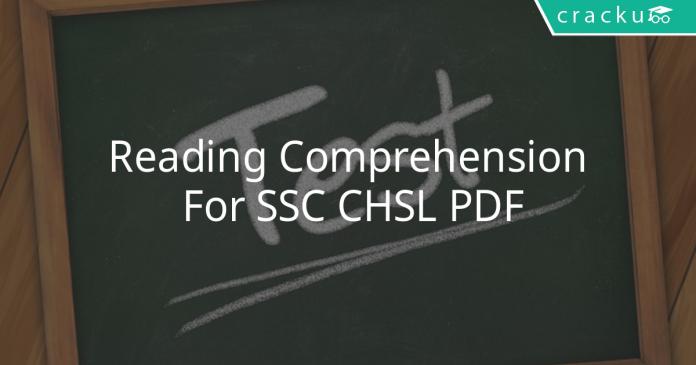Reading Comprehension For SSC CHSL PDF
SSC CHSL Constable Comprehension Question and Answers download PDF based on previous year question paper of SSC GD exam. 20 Very important Reading Comprehension questions for CHSL Constable.
READING COMPREHENSION FOR SSC CHSL PDF
285 SSC Mocks for just Rs. 249
Download SSC CHSL Topic Wise Questions PDFs
Practice SSC CHSL Study Material
Instructions
Read the following passage carefully and answer the questions. Certain words/phrases are given in bold to help you locate them while answering some of the questions.
Until the 1960s boys spent longer and went further in school than girls, and were more likely to graduate from university. Now, across the rich world and in a growing number of , poor countries, the balance has tilted the other way. Policymakers once fretted about girls’ . lack of confidence in science but this is changing. Sweden has commissioned research into its “boy crisis”. Australia has devised a reading programme called “Boys, Blokes, Books and Bytes”. In just a couple of generations, one gender gap has closed, only for another to open up. The reversal is laid out in a report published on March 5th by the OECD. a Paris based Rich country thinktank. Boys’ dominance just about endures in maths: at age 15 they are, on average, the equivalent of three months’ schooling ahead of girls. In science the results are fairly even. But in reading, where girls have been ahead for some time, a gulf has appeared. In all G4 countries and economies in the study, girls outperform boys. The average gap is equivalent to an extra year of schooling. The OECD deems literacy to be the most important skill that it assesses, since further learning depends on it. Sure enough, teenage boys are 50% more likely than girls to fail to achieve basic proficiency in any of maths, reading and science. Youngsters in this group, with nothing to build on or shine at, are prone to drop out of school altogether. To see why boys and girls fare so differently in the classroom, first look at what they do outside it. The average 15year old girl devotes five and half hours a week to homework, an hour more than the average boy, who spend more time playing video games and trawling the internet. Three quarters of girls read for pleasure, compared with little more than half of boys. Reading rates are falling everywhere as screens draw eyes from pages, but boys are giving up faster. The OECD found that, among boys who do as much homework as the average girl, the gender gap in reading fell by nearly a quarter.
Once in the classroom, boys long to be out of it: They are twice as likely as girls to report that school is a “waste of time”, and more often turn up late. Just as a teacher sused to struggle to persuade girls that science is not only for men, the OECD now urges parents and policymakers to steer boys away from a version of masculinity that ignores academic achievement. Boys’ disdain for school might have been less irrational when there were plenty of jobs for uneducated men. But those days have long gone. It may be that a bit of swagger helps in maths, where confidence plays a part in boys’ lead (though it sometimes extends to delusion:12% of boys told the OECD that they are familiar with the mathematical concept of “subjunctive sealing”, a red herring that fooled only 7% of girls.) But their lack of self Visit discipline drives teachers crazy. The OECD found that boys did much better in its anonymised tests than in teachers assessments. What is behind this discrimination? One possibility is that teachers mark up students who are polite, eager and stay out of flights, all attributes that are more common among girls. In some countries, academic points can even be docked for bad behaviour.
Question 1: Which of the following is an appropriate title for the passage ?
a) Finding the Glass Ceiling
b) Men Storming Up the Irony Tower
c) Pay and Job Flexibility
d) Attention! A New Gender Gap
e) A Broken Safety Net
Question 2: Which of the following best describes the author’s opinion about the `boy crisis’?
a) It is not as much of a problem as it is made out to be.
b) Policymakers should address the issue of ‘uneducated’ boys as it will impact boys
employment subsequently.
c) It can be addressed by implementing quotas at university level.
d) It is a rich country phenomenon and can be easily addressed through increased funding for schools.
e) None of the given options
Question 3: Choose the word which is opposite in meaning to the word DELUSION given in bold as used in the passage.
a) Myth
b) Superstition
c) Precipitating
d) Reality
e) Familiarity
Question 4: What do the OECD statistics in the passage indicate ?
a) Schools dropout rates among boys are higher in developing countries than in rich ones.
b) Despite the perception that girls are doing better than boys in school, the same is not true.
c) Today boys are more at risk than girls in terms of educational achievement in developed countries.
d) Enrolment of girls in schools has doubled while that of boys has fallen.
e) By and large teenagers have very low educational achievement in rich countries.
Question 5: Which of the following factors can have an impact on results of boys in school ?
A. Perceptions of teachers
B. Societal attitude towards educational achievement and boys
C. Overconfidence of male students
a) Only (A)
b) Only (B)
c) All (A), (B) and (C)
d) Only (A) and (C)
e) Only (A) and (B)
Question 6: Choose the word/group of words which is most nearly the same in meaning as the word PRONE given in bold as used in the. passage.
a) Unconscious
b) Flat
c) Likely
d) Lifeless
e) Opinionated
Question 7: Which of the following is TRUE in the context of the passage ?
a) Boys perform better than girls on subjective teacher assessments.
b) Efforts to improve representation of girls in education have had success.
c) By and large teachers are female and they discriminate against boys.
d) Education in rich countries needs to be subsidised to reduce dropout numbers.
e) None of the given statements is true in the context of the passage.
Question 8: Choose the word/group of words which is most nearly the same in meaning as the word DRAW given in bold as used in the passage.
a) Sketch
b) Tie
c) Raffle
d) Represent
e) Divert
Question 9: According to the passage, what can be said about the school education today ?
a) Science education is deteriorating rapidly.
b) Online education can easily address its problems such as shortage of teaching staff.
c) It fosters rote learning instead of creative thinking.
d) The amount of homework for children is prohibitive.
e) Girls are doing better at school as compared to boys on some parameters.
Question 10: Choose the word which is opposite in meaning to the word DOCKED given in bold as used in the passage.
a) Raised
b) Stopped
c) Widened
d) Flown
e) None of these
DOWNLOAD APP TO ACESS DIRECTLY ON MOBILE
Instructions
Read the following passage and answer the questions that follow:
Schools find their existence tied to community standards and financial restraints based on the community support… or lack of. The result is that schools are closing at an alarming rate across the country. The decision to close a school rarely reflects the needs of a community or, more importantly, the needs of the students!
There seems to be less concern for the needs of the communities children’s education than the economic demands of the location of the school or the resources available. Where is the federal government when this happens? Well, they are partially to blame. The government rhetoric details the need for affordable, quality education while they demand that school systems adhere to specific federal mandates that tie the school administration’s hands to comply with political wants. So much for federal support.
How many kids can you cram into a classroom and still teach effectively? That depends on whether you are looking to teach the children or be a daycare service. I know, pretty harsh but look at the function of schools today. They take your children and house them and feed them for about 6-7 hours a day. Mostly providing them with basic discipline and food that they rarely get at home! Oh yes, admit it. Teachers are required to discipline your children in a crowded atmosphere where safety is no longer guaranteed and education takes a back seat to providing basic needs that parents are unwilling to, uneducated to or unable to provide. Wait, what about education? Well, there is so little time for that that caring for them takes priority over teaching them.
Secondarily, because of the constraints of federally-mandated guidelines, the children are taught in a cookie-cutter style standard of personality-limiting, creative-minimizing and individually-restrictive processes to get them to their adulthood. Basic education with basic performance that aligns children to basic standards that align with everyone else’s basic needs. Sad because it is done in crowded classrooms where teachers are forced to “teach” more children than one person could attend to. How effective is that?
According to the U.S. Bureau of Labor Statistics and the U.S. Education Department, 80% of all high school students graduate and student graduation rates are at an all-time high. This sounds great doesn’t it? Well, no it doesn’t because about 80% of high school seniors cannot pass basic proficiency exams or read at a basic level. The fundamental and core foundation for a successful future lies in their ability to read and comprehend and it is failing miserably. Because of a politically-correct mindset and an unwillingness to admit that we are failing we are passing kids without prejudice. What is the dynamic here? Money, acknowledgment, standards, social constraint?
With fewer than 40% of graduating students able to perform basic reading and math skills, what will their future look like? Poor at best because they are set up for failure and aren’t educated enough to know it. They are not prepared for any part of life let alone future education without the basic skills to learn. It seems a path to socialism.
With the lack of people who are willing to sacrifice their future for low-paying academic careers there is little to choose from in the way of well-educated teachers. Enter teachers. As student education becomes more technology-supported so must teacher innovation education. A once-proud career, teachers are opting for more industrial careers using their basic educational achievements because it pays more and is less restricting. A lack of qualified teachers translates to a lack of quality education from under qualified teachers. The cultural shift in classrooms demands an academic shift in recognizing and utilizing qualified teachers who must meet higher-level standards before being allowed to teach.
Alas, distance learning take the personalization from the process, individualism from the practice and allows for lesser-educated teachers to perform office-like academics instead of teaching-like practices. Poorly educated teachers who are not held to the highest standards will produce poorly-educated students who will perpetuate the same. Pay teachers better and demand more from them and we will produce quality educated people. There is something askew when ball players make millions and teachers make nothing! Time to rethink this one.
Article Source: ezinearticles.com
Question 11: Which of the following is the most opposite in meaning to the word ‘proficiency’ as used in the passage?
a) Knowledge
b) Acumen
c) Ability
d) Incompetence
e) Expertise
Question 12: Which of the following is the most opposite in meaning to the word ‘prejudice’ .
a) Inclination
b) Proclivity
c) Fair
d) Bias
e) Subjectivity
Question 13: What is meant by the word ‘restrains’ used in the paragraph?
a) Constrains
b) Freedom
c) Resources
d) Pain
e) Prodigality
Question 14: Which of the following is closest in meaning to the word ‘rhetoric’ used in the passage?
a) Extravagant language
b) Policy
c) Interests
d) Agenda
e) Proposals
Question 15: What is the author’s view about distance learning programs?
a) They are good since they are cheap
b) Distance learning programs lack personalization and hence, are incomplete.
c) Distance learning programs facilitate educational inclusion and hence, are good.
d) Distance learning programs cater to individual needs and produce efficient teachers
e) Poorly educate teachers deliver distance learning programs lowering the quality
FREE SSC PRACTICE SET (DAILY TEST)
Question 16: What is the central theme of the passage?
a) Society and its misplaced priorities
b) Side effects of being politically correct
c) Poor pay structure of teachers and its repercussions
d) The fundamental flaws in the US educational system
e) The real value of paper qualifications
Question 17: From the information given in the passage, it can be inferred that
a) The author holds capitalism high in esteem
b) The author holds socialism in bad light
c) The author feels that teachers must earn more than ball players
d) The author feels that the federal government is solely responsible for the degradation of the educational system
e) None of the above
Question 18: According to the passage, the number of graduates is at a all time high. But the author is unhappy with the results because
a) More and more people are getting educated but there is a dearth of jobs
b) More people getting educated will significantly alter the supply-demand dynamics
c) Though they are educated on paper, they lack even basic proficiency
d) Education is getting costlier and student debts are at an all time high
e) Lack of moral education in the curriculum leads to arrogant, self-centred people.
Question 19: The lack of good teachers can be mainly attributed to
a) High job satisfaction in corporate careers
b) Low job satisfaction in teaching career
c) Presence of disinterested students in the class
d) Low pay in the teaching career
e) Tight frameworks laid down by the federal government
Question 20: What does the author mean by “cookie-cutter style”?
a) Molding students to be sharp and quick witted
b) Producing similar products with little to no innovation using template methods.
c) Ability to take a decision in a precise manner
d) Personalized education style tailored for the specific needs of individual students.
e) Minimizing errors through creative thinking
Answers & Solutions:
1) Answer (D)
2) Answer (B)
3) Answer (D)
4) Answer (D)
5) Answer (C)
6) Answer (C)
7) Answer (B)
8) Answer (E)
9) Answer (E)
10) Answer (B)
11) Answer (D)
’proficiency’ refers , ‘competency’. Hence, ‘incompetence’ is the right answer.
12) Answer (C)
’Prejudice’ means to have a bias. Fair is the word opposite to ‘prejudice’.
13) Answer (A)
‘Restrains’ means conditions or restrictions. Constrains is the word closest in meaning among the given options.
14) Answer (A)
Rhetoric means persuasive language. Hence, option A is the right answer.
15) Answer (B)
The author feels that distance education lacks personal touch and does not develop individualistic qualities. Hence, option B is the right answer.
16) Answer (D)
The passage, as a whole, deals with the flaws in the education system due to federal government, poor teachers and schools that have turned into care centres. Hence, option D is the right answer.
17) Answer (B)
By the end of sixth paragraph, the author remarks that students lacking even basic proficiency may lead to socialism like situation. Hence, it is clear that socialism is not in the good books of the author.
18) Answer (C)
In the fifth and sixth paragraphs, the author mentions that even though the number of graduates has increased, most of them fail even basic proficiency tests. Hence, option C is the right answer.
19) Answer (D)
The author mentioned that teachers join industries using their lower qualifications as the pay is better. In the last 2 paragraphs, the author emphasizes how low pay has failed to attract top talents to teach resulting in teachers of poor quality. Hence, option D is the right answer.
20) Answer (B)
By Cookie Cutter Style, The author describes the lack of personalization in education. Hence option B is the right answer.
Free SSC CHSL Mock Test Series
DOWNLOAD APP FOR SSC FREE MOCKS
We hope this parajumble questions for SSC CHSL will be highly useful for your preparation.





